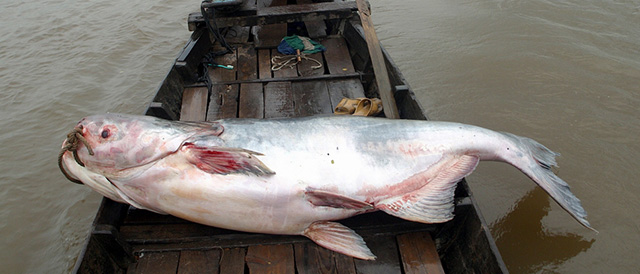| Pangasiidae (Shark catfishes) |
| 300 cm TL (male/unsexed); 235 cm SL (female); max.weight: 350 kg; max. reported age: 10 years |
|
benthopelagic; freshwater, potamodromous |
| Asia: endemic to the Mekong basin where it has become rare due to overexploitation. |
|
Dorsal spines (total): 2-2; Dorsal soft rays (total): 7-8; Anal soft rays: 35; Vertebrae: 48-48. Body without stripes; posterior nostril located near anterior nostril; 7 branched dorsal-fin rays; gill rakers rudimentary or absent; fins grey, never black (Ref. 12693). The center of the eye above the horizontal line through the mouth angle in juveniles; eye totally below the level of mouth angle in subadults and adults. The maxillary and mandibulary pairs of barbels well developed in juveniles; mandibulary barbels become rudimentary in subadults and adults (Ref. 9448). Gigantic size; oral teeth and gill rakers present in small juveniles, absent at about 30-50 cm SL; dorsal, pelvic and pectoral fins without filamentous extensions (Ref. 43281). Distinguished from other large catfish in the Mekong by its lack of teeth and the almost complete absence of barbels (Ref. 2686) |
| A migratory species (Ref. 37772) which occurs in medium to large-sized rivers (Ref. 12975). Feeds on detritus and algae on the bottom (Ref. 58784); feeds only on vegetation in the river but takes other food in captivity; little is known on its general pattern of life and migratory journeys for spawning (Ref. 2686). Shows one of the fastest growth rates of any fish in the world, reaching 150 to 200 kg in 6 years (Ref. 12693). Cited in the Guinness Book of Records as largest freshwater fish (Ref. 6472). Marketed fresh (Ref. 12693). Maximum length of 300 cm needs confirmation. Threatened due to over harvesting and habitat loss (Ref. 58490). |
|
Critically Endangered (CR); Date assessed: 13 April 2011 (A4abcd) Ref. (130435)
|
| harmless |
|
Occurs in Ubon Ratchathani and Chiang Rai (Ref. 37773). Artificially reproduced fry from artificial breeding program by Department of Fisheries since the 1980s released in the Mekong, the Chao Phraya and natural waters in Thailand (Ref. 7432). Stocked in various reservoirs. Offspring attains a very quick growth, but unsuccesful to develop reproducing gonads in aquaculture condition (Ref. 43281). Highly priced food fish (Ref. 6459). Locally rare in the markets, but popular in pond culture. Threatened due to overfishing (Ref. 58784). Also Ref. 9448, 9648, 26336.
Status of threat: Critically Endangered (Ref. 58784). |
Source and more info: www.fishbase.org. For personal, classroom, and other internal use only. Not for publication.

